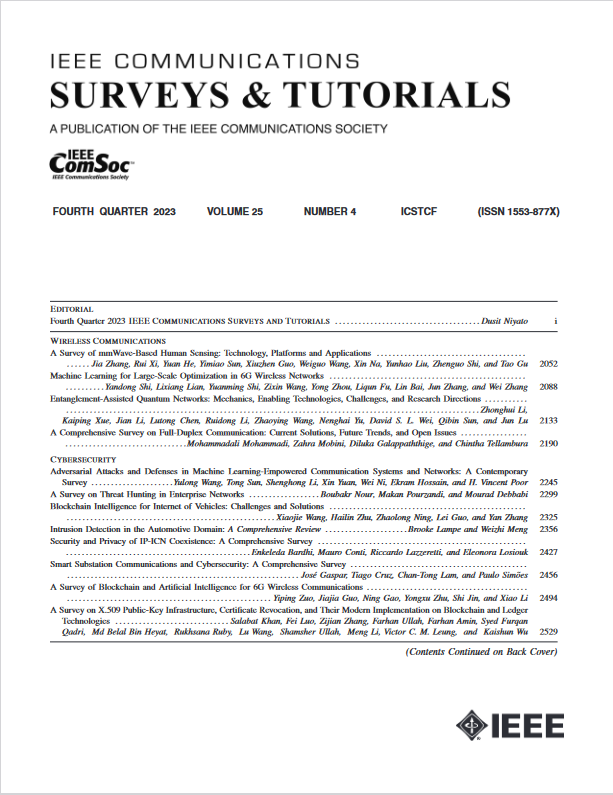A Survey on Indoor Visible Light Positioning Systems: Fundamentals, Applications, and Challenges
IF 34.4
1区 计算机科学
Q1 COMPUTER SCIENCE, INFORMATION SYSTEMS
引用次数: 0
Abstract
The growing demand for location-based services in areas like virtual reality, robot control, and navigation has intensified the focus on indoor localization. Visible light positioning (VLP), leveraging visible light communications (VLC), becomes a promising indoor positioning technology due to its high accuracy and low cost. This paper provides a comprehensive survey of VLP systems. In particular, since VLC lays the foundation for VLP, we first present a detailed overview of the principles of VLC. Then, we provide an in-depth overview of VLP algorithms. The performance of each positioning algorithm is also compared in terms of various metrics such as accuracy, coverage, and orientation limitation. Beyond the physical layer studies, the network design for a VLP system is also investigated, including multi-access technologies, resource allocation, and light-emitting diode (LED) placements. Next, the applications of the VLP systems are overviewed. Finally, this paper outlines open issues, challenges, and opportunities for the research field. In a nutshell, this paper constitutes the first holistic survey on VLP from state-of-the-art studies to practical uses.室内可见光定位系统概览:基本原理、应用和挑战
在虚拟现实、机器人控制和导航等领域对基于位置的服务的需求不断增长,加强了对室内定位的关注。利用可见光通信技术(VLC)的可见光定位(VLP)以其精度高、成本低的特点,成为一种很有前途的室内定位技术。本文对VLP系统进行了全面的综述。特别是,由于VLC为VLP奠定了基础,我们首先详细概述了VLC的原理。然后,我们提供了VLP算法的深入概述。本文还比较了每种定位算法在精度、覆盖范围和方向限制等方面的性能。除了物理层研究之外,还研究了VLP系统的网络设计,包括多址技术、资源分配和发光二极管(LED)的放置。接下来,概述了VLP系统的应用。最后,本文概述了研究领域的开放性问题、挑战和机遇。简而言之,本文构成了从最新研究到实际应用的VLP的第一个整体调查。
本文章由计算机程序翻译,如有差异,请以英文原文为准。
求助全文
约1分钟内获得全文
求助全文
来源期刊

IEEE Communications Surveys and Tutorials
COMPUTER SCIENCE, INFORMATION SYSTEMS-TELECOMMUNICATIONS
CiteScore
80.20
自引率
2.50%
发文量
84
审稿时长
6 months
期刊介绍:
IEEE Communications Surveys & Tutorials is an online journal published by the IEEE Communications Society for tutorials and surveys covering all aspects of the communications field. Telecommunications technology is progressing at a rapid pace, and the IEEE Communications Society is committed to providing researchers and other professionals the information and tools to stay abreast. IEEE Communications Surveys and Tutorials focuses on integrating and adding understanding to the existing literature on communications, putting results in context. Whether searching for in-depth information about a familiar area or an introduction into a new area, IEEE Communications Surveys & Tutorials aims to be the premier source of peer-reviewed, comprehensive tutorials and surveys, and pointers to further sources. IEEE Communications Surveys & Tutorials publishes only articles exclusively written for IEEE Communications Surveys & Tutorials and go through a rigorous review process before their publication in the quarterly issues.
A tutorial article in the IEEE Communications Surveys & Tutorials should be designed to help the reader to become familiar with and learn something specific about a chosen topic. In contrast, the term survey, as applied here, is defined to mean a survey of the literature. A survey article in IEEE Communications Surveys & Tutorials should provide a comprehensive review of developments in a selected area, covering its development from its inception to its current state and beyond, and illustrating its development through liberal citations from the literature. Both tutorials and surveys should be tutorial in nature and should be written in a style comprehensible to readers outside the specialty of the article.
 求助内容:
求助内容: 应助结果提醒方式:
应助结果提醒方式:


